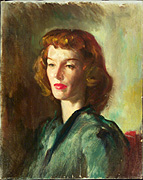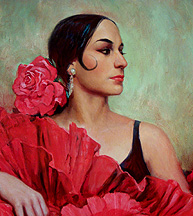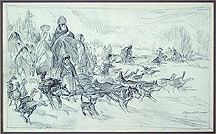Reynold Brown
Fine Art Paintings 1970-1976
Although better known nationally for his movie illustrations Reynold Brown
did many paintings and drawings for the Fine Arts Market. Some of this material
was produced while he was also doing illustration work.
When he first returned from New York in 1951 he took a few classes with noted
portrait artist Will
Foster in Los Angeles. This very much affected his choice of colors and for many
years in his fine arts work he tended to use muted colors. This may also be at
least in part due to his German/British  heritage. The early portraits
included a series of artist's model "Camille". The portraits, mostly
studies, are generally subdued, not only in color, but also in presentation. It
may be that they provided a quiet place to paint in comparison to the extreme
action and drama required for Brown's movie and magazine illustration. This
early experience caused Brown to use muted colors in his landscapes and western
scenes generally.
heritage. The early portraits
included a series of artist's model "Camille". The portraits, mostly
studies, are generally subdued, not only in color, but also in presentation. It
may be that they provided a quiet place to paint in comparison to the extreme
action and drama required for Brown's movie and magazine illustration. This
early experience caused Brown to use muted colors in his landscapes and western
scenes generally.
Besides the portrait Brown did a series of seascapes and landscapes. Most,
although not all, of these his ocean scenes were in the harbors near Los
Angeles. His landscapes were generally of the chaparral region of California as
well as its desert areas.
Reynold Brown became angered by the changes in Hollywood and the type of
movie commissions he was getting, especially those from American International
Pictures (AIP) and was frustrated by the poor quality of the movies he was
getting commissions on. These were often hells angels, or sleazy types of
movies. Mary Louise encouraged him to quit doing this type of work. He finally
did so in 1970. He was very worried about how he was going to pay his bills. About two days after taking the material back in to the studios Brown received a
call from Perry House Gallery in Monterrey, CA. The owner had heard about
his work (possibly through his friend and their client, artist/illustrator
Donald Teague). Brown took his desert landscapes, and recognizing the recent
growing interest in western subject paintings, painted cowboys into them.
 Brown set up a studio in San Gabriel, CA, near the mission, with his former
teacher and life long friend, Lester Bonar. interruptions from visitors made
work difficult so he moved his studio back home, to La Verne, CA where he had
worked since 1954.
Brown set up a studio in San Gabriel, CA, near the mission, with his former
teacher and life long friend, Lester Bonar. interruptions from visitors made
work difficult so he moved his studio back home, to La Verne, CA where he had
worked since 1954.
He was painting a subject he liked and over the next few years became popular
in the western arts market. He was among the first artists to be shown in
Trailside Gallery. This gallery would become one of the leaders in the western
art market in what was then a quiet little town, Jackson, WY.
Brown quickly shifted from the quiet landscapes to story telling. His
paintings were filled with cattle rustlers, stampedes and indian hunting
parties. He was moving to a more historical approach, painting scenes based on
his readings of western history. In 1976
His paintings receiving wide acclaim Brown seemed destined to be one of the
top names in the western art market, but in 1976. That spring he was working on
an historical piece, "The Demise of the Madam." Placed in Virginia
City, NV in 1867, it showed a funeral march for Julia Bulette, one of the first
pioneers in the area and owner of the local brothel. For the members of the
crowd Brown used his own friends, doctors, neighbors, even the milkman. But the
work was not completed, Brown suffered a massive heart attack and stroke.
Although Reynold Brown the artist survived, the meticulous painter of a
realistic scene did not.
|
Click image for larger view |
|

|

|

|

|
 |

|
|
to Post-stroke paintings
Home / Site
Contents / to Fine Arts introduction
 heritage. The early portraits
included a series of artist's model "Camille". The portraits, mostly
studies, are generally subdued, not only in color, but also in presentation. It
may be that they provided a quiet place to paint in comparison to the extreme
action and drama required for Brown's movie and magazine illustration. This
early experience caused Brown to use muted colors in his landscapes and western
scenes generally.
heritage. The early portraits
included a series of artist's model "Camille". The portraits, mostly
studies, are generally subdued, not only in color, but also in presentation. It
may be that they provided a quiet place to paint in comparison to the extreme
action and drama required for Brown's movie and magazine illustration. This
early experience caused Brown to use muted colors in his landscapes and western
scenes generally.  Brown set up a studio in San Gabriel, CA, near the mission, with his former
teacher and life long friend, Lester Bonar. interruptions from visitors made
work difficult so he moved his studio back home, to La Verne, CA where he had
worked since 1954.
Brown set up a studio in San Gabriel, CA, near the mission, with his former
teacher and life long friend, Lester Bonar. interruptions from visitors made
work difficult so he moved his studio back home, to La Verne, CA where he had
worked since 1954. 




